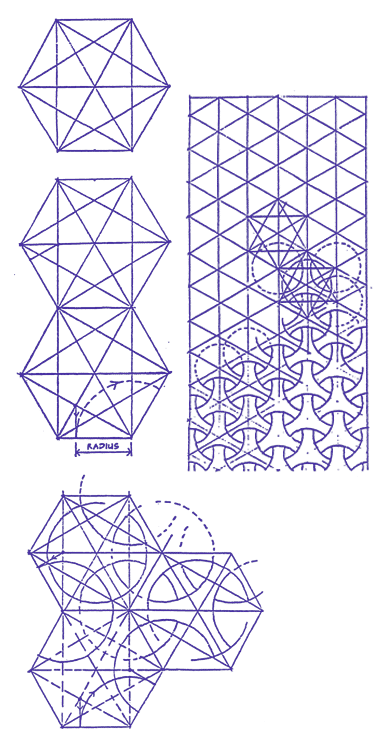Network: Equilateral Triangles: Japan
 Japanese pattern design is one of the most brilliant applications of basic geometric constructions in the domain of visual design. Japanese craft workers have used these patterns on a multiplicity of surfaces and materials, from fabrics and papers to wood carvings and ceramics. The pattern shown here is one of those based upon the hexagon.
Japanese pattern design is one of the most brilliant applications of basic geometric constructions in the domain of visual design. Japanese craft workers have used these patterns on a multiplicity of surfaces and materials, from fabrics and papers to wood carvings and ceramics. The pattern shown here is one of those based upon the hexagon.
- Construct a regular Hexagon and connect all it’s apices, forming a network. That is, connect Points A, B, C, D, E, and F to derive lines AC, AE, AD, lines BD, BE, BF, lines CF and CE, and line DF.
- Where Line FD intersects Line EB at Point X ,drop a perpendicular to line ED to locate Point Y.
- With Point D as centre, radius equal to DY, swing an arc about D to meet Line DC at point Z.
- Repeat this practice for each successive edge line of the Hexagon ( ED-DC, DC-CB, CB-BA, BA-AF, AF-FE, FE-ED)
- Place hexagons together to form a hexagonal field pattern or network, repeating the process for each separate Hexagon.
- Select arcs as shown so as to create the illusion of an inter-woven network of shapes.
This pattern will be useful for ceramic tile designers, wood-workers, metal crafters, quliters, fabric designers, and others who use patterns in their design work. While the final appearance appears complex, the construction shown explains clearly how logical and straight-forward the design actually is. It is the realization of the ultimate simplicity underlying the pattern that increases the viewer’s engagement and aesthetic enjoyment.